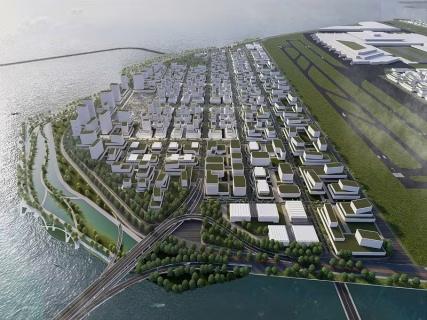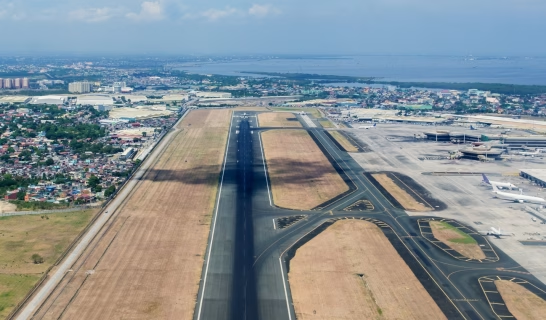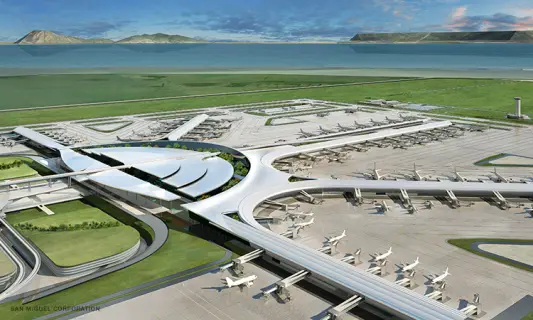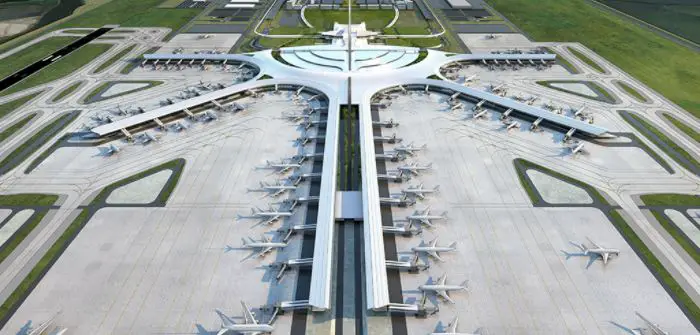Updated November 25, 2025:
One of the world’s largest airports in the Philippines, the New Manila International Airport has been marked as a sinking airport. Earlier this year, Global Witness noted that the airport projections were overly optimistic as it entirely disregarded the risks. Once complete, the airport is expected to cover 2,500 hectares of land. This is twice as big as the JFK International Airport. Furthermore, it is nearly three times bigger than Sydney Airport. It will also have the capacity of handling 100 million annual passengers.
The problem is that within 30 years, sinking land and floods could render this $15 billion project defunct. The reason for construction is to ease the pressure currently being experienced by the nation’s busiest and biggest airport, Ninoy Aquino International. The airport received 50 million people last year through its terminals. However, Ninoy Aquino wasn’t designed for this level of traffic. It was only meant to handle between 35 and 40 million passengers each year. Because of the increase, this airport is gaining a reputation for major crowding and delays. However, with Manilla fully occupied and Ninoy Aquino locked in, there is no room for expansion. Hence, a new airport was considered. Access to the airport will be made possible by projects such as the interconnected bridge and infrastructure innovation in the Philippines which the Asian Development Bank allocated $650 million.
Project Factsheet
- Project: New Manila International Airport
- Place: Bulacan, Philippines
- Value: US$15 billion
- Scale: 2,500 hectares – twice JFK, nearly 3× Sydney Airport
- Capacity: 100 million passengers annually
- Objective: To ease congestion at Ninoy Aquino International Airport
Key Concerns
- Marked as a “sinking airport” due to land subsidence, flooding risk, and sea-level rise
- Built on reclaimed seabed with soft marine clay and loose granular soils.
- Region exposed to typhoons, storm surges, and seismic activity
- Risk projections also suggest potential runway inundation in 30 years
- Ground & Coastal Engineering Works
- Large-scale dredging and sand reclamation by Boskalis
- Dynamic compaction with 10–20 ton weights
- Ground Stabilization Systems: geogrids, deep cement mixing, vertical drains, vibroflotation
- Perimeter rock revetments for typhoon and tidal protection
- Platform raised ~4 meters above sea level
Additional Infrastructure
- Two major expressways
- Rail links
- Development of a wider 12,000-hectare zone
Core Challenge
- Threatened by sinking land, rising seas, and extreme weather that put the project’s future functionality at risk.
Scope of Implementation on One of Asia’s Largest Airports
Advanced ground-improvement and coastal-protection systems help New Manila International Airport turn the reclaimed seabed into a stable aviation platform. Large dredging sums are being executed by Boskalis with trailing suction hopper dredgers, sucking up and moving suitable sand onto the fill area. Dynamic compaction involves dropping 10–20-tonne weights multiple times to compact loose layers and squeeze out pore water from the fill once it has been laid. Furthermore, supplementary stabilization systems include geogrids and deep cement mixing, prefabricated vertical drains, and vibroflotation.

These are used to counteract soft-soil conditions and to rapidly develop consolidation. The perimeter protection utilizes engineered rock revetments against tidal erosion. Moreover, it prevents against possible typhoon-driven waves. The finished elevation of the platform will lie approximately four meters above the existing sea level in order to reduce flood risk. Besides the platform itself, the implementation scope encompasses the building of two major expressways, rail links, and the phased preparation of a wider 12,000-hectare development zone.
The Challenge Facing the New Manila International Airport
The challenge facing the New Manilla International Airport is the projected sinking and flooding. If this happens, it would render the project entirely futile and waste much resources. The land for this airport is being raised from the sea. Furthermore, its location on reclaimed land at the edge of Manila Bay also poses a challenge. The site is being created out of the sea by dredged sand, a process inherently associated with soil liquefaction, settlement, and long-term land subsidence. The underlying strata also have soft marine clay and loose granular material, which raise the risk of deformation by seismic events. Furthermore, storm surges, and tidal pressures may also be a problem.

These risks are compounded by the region’s exposure to typhoons and its position within the Pacific Ring of Fire. A key concern is the sea-level rise. Although the developer estimates a rise of about 5.3 mm per year until 2050, independent analysis shows that Manila Bay may experience up to 13–15 mm per year due to changes in ocean temperatures, and current shifts. This sets up a potential situation where flooding, overtopping of land defenses, and runway inundation could happen in decades.
September 20, 2023:
The latest
The development of the P740-billion New Manila International Airport (NMIA) north of Metro Manila will be completed by the end of 2025. This was recently affirmed by the project developer San Miguel Corp. (SMC) in its fund-raising proposal.
From November 2023, the company intends to sell up to P65 billion worth of shares in the NMIA project. The proceedings will reportedly be used to pay debts and to support its airport ambitions. These ambitions include bankrolling the 2,500-hectare aerotropolis located approximately 28.5 aerial kilometres from Ninoy Aquino International Airport (Naia).
Through Ramon S. Ang, the company’s president, SMC also maintained that New Manila International Airport shall begin commercial operations in 2026 as planned.
Meanwhile, the overall progress at the project site has passed the halfway mark. In June 2023 the project was 68.92% complete. Site clearance, landfilling works, and ground improvement works were 98.3%, 66.59% and 66.54% completed respectively.
According to the company, its team continues to work on the airport master plan along with the critical components of the airport. San Miguel Aerocity Inc. on the other hand is working with various parties for the design, construction, and financing of other critical components of the airport.
New Manila International Airport (Bulacan International Airport) project overview
The New Manila International Airport also known as the Bulacan International Airport project involves the construction, operation & maintenance of a new modern international airport on a 2,500-hectare piece of land in the coastal areas of Bulakan, a 1st class municipality in the province of Bulacan in Manila, the capital of the Philippines.
Proposed by the San Miguel Corporation (SMC), one of the Philippines’ largest and most diversified conglomerates, the ₱735.634-billion airport project is part of an envisioned 12,000-hectare township that features a residential zone, government centre, seaport, and an industrial zone.
Also Read: Bugesera International Airport (BIA) project and all you need to know
The New Manila International Airport, upon completion, will feature at least four runways, which are expandable to six, passenger terminal buildings with airside and landside amenities and other airport facilities.

It will have a capacity of 200 million passengers per year, which is about six times larger than the current capacity of Ninoy Aquino International Airport (NAIA), the airport that is currently serving Manila and its surrounding metropolitan area.
The New Manila International Airport will be connected to Metro Manila by an airport toll road with connections to the North Luzon Expressway and Radial Road 10, and it will also be connected by rail to the MRT Line 7 through the MRT 7 Airport Express project.
New Manila International Airport project team
The contract for the design and construction of the New Manila International Airport was awarded to; ADP Ingénierie, a wholly-owned subsidiary of Groupe ADP that carries out architectural and engineering activities worldwide dealing with the design of new airports or existing airport development.
Meinhardt Group, a world-class engineering consulting firm of designers, planners, engineers, managers, architects, consultants, and technical specialists; and Jacobs Engineering Group, an engineering company that offers design, construction, consulting, and maintenance services for clients in a diverse range of industries, are also a part of the project design and construction team.
Royal Boskalis Westminster N.V., a Dutch dredging and heavy lift company that provides services relating to the construction and maintenance of maritime infrastructure internationally, was selected for the development of approximately 1700 hectares of land for the new airport.
New Manila International Airport project timeline
2017
San Miguel Corporation, in February, proposed the construction of the airport.
2018
The National Economic and Development Authority (NEDA) Board approved the proposal in April 2018.
In November, Incheon International Airport Corporation (IIAC) also signed a Memorandum of Understanding with the San Miguel Corporation to collaborate on the development and operation of the new airport.
In the following month, NEDA approved the negotiation report on the Concession Agreement (CA) regarding the project.
2019
In September, San Miguel Aerocity Inc., a unit of San Miguel Corporation was awarded a close to US$ 14bn contract to oversee the implementation of the New Manila International Airport project.
2021
In March, Arthur Tugade, the Philippines’ Department of Transportation Secretary reported that the groundbreaking ceremony of the New Manila International Airport project will take place in Q2 2021.
Mr. Tugade stated the department hopes to do a formal inauguration by April or May 2021 at the latest adding that the project is expected to be completed in four to six.


Yeah, but what happened on this airport project plan? I thought the groundbreaking will take place on August 2021. But what happened? Is there any groundbreaking ceremony that happened last August 2021?